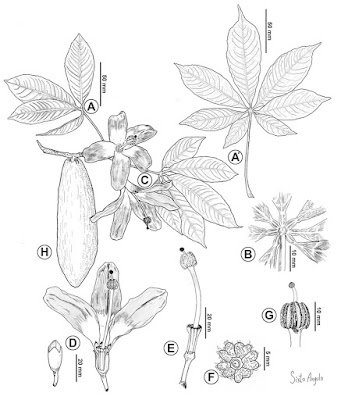 |
| Ceiba camba Drawert, Angulo & Catari, in Drawert, Angulo & Catari, 2024. |
Abstract
Based on the review of herbarium specimens, geo-referenced live images, and field observations, a new species of the genus Ceiba (Malvaceae) is described. Ceiba camba, the new species, has previously been confused with other species in the Ceiba insignis complex, specially with C. speciosa, and went undifferentiated despite having a wide distribution in the lowlands of central-western South America and being quite common. However, the new species here described shows clear visible morphological differences from C. speciosa and the other members of the genus. The main similarities and differences with other morphologically and geographically close species of the C. insignis complex (C. chodatii, C. crispiflora, C. insignis, C. lupuna, C. pubiflora, C. speciosa) are discussed.
Key words: Chiquitania, pink bottle tree, Southwest Amazon, floss silk tree, toborochi
Ceiba camba Drawert, Angulo & Catari, sp. nov.
It differs from all species of the genus Ceiba by the combination of short and winged petiolules; calyx cylindrical to elongated-campanulate; petals distally pale pink to magenta and basally white to deep yellow; 5 lobed staminal appendages, lobes bifid, scarcely pilose to pilose and whitish, yellow to pinkish; stamens fused into staminal tube; and stigma deep red to carmine.
Etymology:—The specific epithet “camba” is a noun used as a demonym to refer to the inhabitants of the eastern lowlands in Bolivia, mainly in the departments of Santa Cruz, Beni and Pando, and largely coincides with the distribution of the species.
Heinz Arno Drawert, Alejandro A. Angulo and Juan C. Catari. 2024. A New Species of Ceiba (Malvaceae, Bombacoideae), previously confused with Ceiba speciosa. Phytotaxa. 636(3); 207-219. DOI: 10.11646/phytotaxa.636.3.1
facebook.com/ColectivoMODOfotovideografia/posts/425594873310796
Resumen A partir de la revisión de muestras de herbario, imágenes en vivo georeferenciadas y observaciones en campo, se describe una nueva especie del género Ceiba (Malvaceae) perteneciente al complejo de Ceiba insignis. Ceiba camba, la nueva especie, hasta ahora ha sido confundida con otras del complejo Ceiba insignis, especialmente C. speciosa, y pasó desapercibida pese a contar con una amplia distribución en las tierras bajas de Sudamérica centroccidental y ser bastante común. Sin embargo, la nueva especie descrita aquí muestra claras diferencias morfológicas visibles con C. speciosa y los otros miembros del género. Se discuten las principales similitudes y diferencias con otras especies del complejo C. insignis (C. chodatii, , C. crispiflora, C. insignis, C. lupuna, C. pubiflora, C. speciosa) morfológica y geográficamente cercanas.
Palabras clave: árbol botella rosado, Chiquitania, Sudoeste Amazonia, árbol de seda, toborochi





